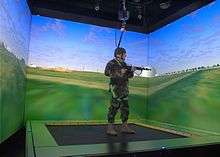Omnidirectional treadmill

An omnidirectional treadmill (ODT) is a mechanical device, similar to a typical treadmill, that allows a person to perform locomotive motion in any direction, allowing for 360 degrees of movement. The ability to move in any direction is how these treadmills differ from their basic counterparts (that permit only unidirectional locomotion). Omnidirectional treadmills are employed in immersive virtual environment implementations to allow unencumbered movement within the virtual space.[1]
Advantages to pairing an ODT with an immersive virtual environment include:
- Natural navigational movement of the system user within the enclosure while still providing contextual cueing which simulate physical traversal through the virtual terrain
- Reverting immersive navigation tasks from hand-based (mouse, joystick) to mentally hard-wired whole body (leg) based
- Enhancing immersion by providing a whole-body experience that begins at the soles of the feet and ends at the top of the head
- Facilitating whole-body haptic interaction
Future directions and discussion
Natural navigation employing the ODT has two fundamental, parallel paths. One path seeks to create wholly immersive, obstruction free environment as in virtual reality, the other seeks a lower cost, more restricted device. The immersive vision is that of a large active surface upon which the user is able to walk freely and unfettered. The second approach employs a harness for tracking, and optionally provides whole-body force feedback.
Both approaches have their advantages and disadvantages. Without a harness, the ODT user is able to accelerate away from center of the surface. The system must recognize this using a variety of sensing means, and gently accelerate the user back towards the center. Keeping the forces that return the user to center below the human sensing threshold is the main challenge with these systems. The larger the active surface, the easier it is to control using this means.
With a harness, the user is kept on center mechanically, and the surface area can be made much smaller. But actions such as rolling are not possible. On the plus side, a harness can provide body forces such as inertia or slope display. In addition, the harness may provide lifting force to simulate free-body flight. And the well-defined user space makes interaction with outside haptic devices feasible.
Omnidirectional treadmills have the potential to also be used in film, such as in conjunction with a green screen. This type of application would allow limitless movement by the actors.[2]
See also
- Cyberith Virtualizer
- List of emerging technologies
- Redirected walking
- Simulated reality
- Virtuix Omni
References
- ↑ Lang, Ben. "Infinadeck is a 1000 Pound Omnidirectional Treadmill Designed and Built By One Man". Road to VR. Retrieved 15 December 2014.
- ↑ Buckley, Sean. "This treadmill lets you walk in any direction". Engadget. Retrieved 17 February 2015.